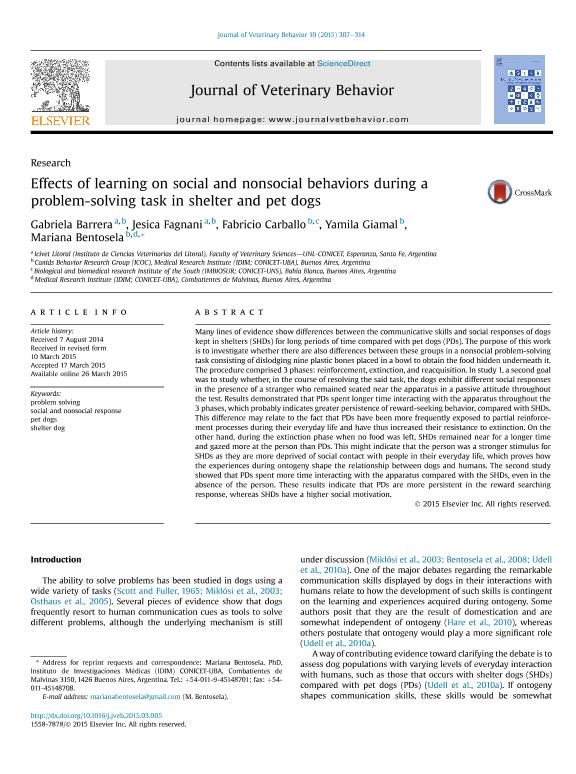Mostrar el registro sencillo del ítem
dc.contributor.author
Barrera, Gabriela Luciana

dc.contributor.author
Fagnani, Jésica Paola

dc.contributor.author
Carballo Pozzo Ardizzi, Fabricio

dc.contributor.author
Giamal, Yamila
dc.contributor.author
Bentosela, Mariana

dc.date.available
2020-10-29T14:47:35Z
dc.date.issued
2015-07
dc.identifier.citation
Barrera, Gabriela Luciana; Fagnani, Jésica Paola; Carballo Pozzo Ardizzi, Fabricio; Giamal, Yamila; Bentosela, Mariana; Effects of learning on social and nonsocial behaviors during a problem-solving task in shelter and pet dogs; Elsevier Science Inc; Journal Of Veterinary Behavior-clinical Applications And Research; 10; 4; 7-2015; 307-314
dc.identifier.issn
1558-7878
dc.identifier.uri
http://hdl.handle.net/11336/117145
dc.description.abstract
Many lines of evidence show differences between the communicative skills and social responses of dogs kept in shelters (SHDs) for long periods of time compared with pet dogs (PDs). The purpose of this work is to investigate whether there are also differences between these groups in a nonsocial problem-solving task consisting of dislodging nine plastic bones placed in a bowl to obtain the food hidden underneath it. The procedure comprised 3 phases: reinforcement, extinction, and reacquisition. In study 1, a second goal was to study whether, in the course of resolving the said task, the dogs exhibit different social responses in the presence of a stranger who remained seated near the apparatus in a passive attitude throughout the test. Results demonstrated that PDs spent longer time interacting with the apparatus throughout the 3 phases, which probably indicates greater persistence of reward-seeking behavior, compared with SHDs. This difference may relate to the fact that PDs have been more frequently exposed to partial reinforcement processes during their everyday life and have thus increased their resistance to extinction. On the other hand, during the extinction phase when no food was left, SHDs remained near for a longer time and gazed more at the person than PDs. This might indicate that the person was a stronger stimulus for SHDs as they are more deprived of social contact with people in their everyday life, which proves how the experiences during ontogeny shape the relationship between dogs and humans. The second study showed that PDs spent more time interacting with the apparatus compared with the SHDs, even in the absence of the person. These results indicate that PDs are more persistent in the reward searching response, whereas SHDs have a higher social motivation.
dc.format
application/pdf
dc.language.iso
eng
dc.publisher
Elsevier Science Inc

dc.rights
info:eu-repo/semantics/openAccess
dc.rights.uri
https://creativecommons.org/licenses/by-nc-sa/2.5/ar/
dc.subject
PET DOGS
dc.subject
PROBLEM SOLVING
dc.subject
SHELTER DOG
dc.subject
SOCIAL AND NONSOCIAL RESPONSE
dc.subject.classification
Otras Psicología

dc.subject.classification
Psicología

dc.subject.classification
CIENCIAS SOCIALES

dc.title
Effects of learning on social and nonsocial behaviors during a problem-solving task in shelter and pet dogs
dc.type
info:eu-repo/semantics/article
dc.type
info:ar-repo/semantics/artículo
dc.type
info:eu-repo/semantics/publishedVersion
dc.date.updated
2020-07-21T20:18:13Z
dc.journal.volume
10
dc.journal.number
4
dc.journal.pagination
307-314
dc.journal.pais
Estados Unidos

dc.journal.ciudad
Amsterdam
dc.description.fil
Fil: Barrera, Gabriela Luciana. Consejo Nacional de Investigaciones Científicas y Técnicas. Centro Científico Tecnológico Conicet - Santa Fe. Instituto de Ciencias Veterinarias del Litoral. Universidad Nacional del Litoral. Facultad de Ciencias Veterinarias. Instituto de Ciencias Veterinarias del Litoral; Argentina. Consejo Nacional de Investigaciones Científicas y Técnicas. Oficina de Coordinación Administrativa Houssay. Instituto de Investigaciones Médicas. Universidad de Buenos Aires. Facultad de Medicina. Instituto de Investigaciones Médicas; Argentina
dc.description.fil
Fil: Fagnani, Jésica Paola. Consejo Nacional de Investigaciones Científicas y Técnicas. Centro Científico Tecnológico Conicet - Santa Fe. Instituto de Ciencias Veterinarias del Litoral. Universidad Nacional del Litoral. Facultad de Ciencias Veterinarias. Instituto de Ciencias Veterinarias del Litoral; Argentina. Consejo Nacional de Investigaciones Científicas y Técnicas. Oficina de Coordinación Administrativa Houssay. Instituto de Investigaciones Médicas. Universidad de Buenos Aires. Facultad de Medicina. Instituto de Investigaciones Médicas; Argentina
dc.description.fil
Fil: Carballo Pozzo Ardizzi, Fabricio. Consejo Nacional de Investigaciones Científicas y Técnicas. Centro Científico Tecnológico Conicet - Bahía Blanca. Instituto de Ciencias Biológicas y Biomédicas del Sur. Universidad Nacional del Sur. Departamento de Biología, Bioquímica y Farmacia. Instituto de Ciencias Biológicas y Biomédicas del Sur; Argentina
dc.description.fil
Fil: Giamal, Yamila. Consejo Nacional de Investigaciones Científicas y Técnicas. Oficina de Coordinación Administrativa Houssay. Instituto de Investigaciones Médicas. Universidad de Buenos Aires. Facultad de Medicina. Instituto de Investigaciones Médicas; Argentina
dc.description.fil
Fil: Bentosela, Mariana. Consejo Nacional de Investigaciones Científicas y Técnicas. Oficina de Coordinación Administrativa Houssay. Instituto de Investigaciones Médicas. Universidad de Buenos Aires. Facultad de Medicina. Instituto de Investigaciones Médicas; Argentina
dc.journal.title
Journal Of Veterinary Behavior-clinical Applications And Research

dc.relation.alternativeid
info:eu-repo/semantics/altIdentifier/url/https://www.sciencedirect.com/science/article/abs/pii/S1558787815000349?via%3Dihub
dc.relation.alternativeid
info:eu-repo/semantics/altIdentifier/doi/https://doi.org/10.1016/j.jveb.2015.03.005
Archivos asociados
